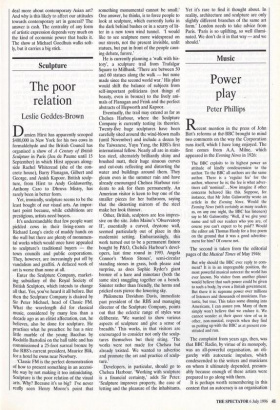Sculpture
The poor relation
Leslie Geddes-Brown
Damien Hirst has apparently scooped $400,000 in New York for his two cows in formaldehyde and the British Council has organised a show of A Century of British Sculpture in Paris (Jeu de Paume until 15 September) in which Hirst appears along- side Rachel Whiteread (she of the con- crete house), Barry Flanagan, Gilbert and George, and Anish Kapoor. British sculp- ture, from Hirst to Andy Goldsworthy, Anthony Caro to Dhruva Mistry, has rarely been in better form.
Yet, ironically, sculpture seems to be the least bought of our visual arts. An impor- tant point because, while exhibitions are prestigious, artists need buyers.
It's understandable that few people want pickled cows in their living-room or Richard Long's circle of muddy hands on the wall but there are plenty of monumen- tal works which would once have appealed to sculpture's traditional buyers — the town councils and public corporations. They, however, are increasingly put off by vandalism and graffiti. A defaced work of art is worse than none at all.
Enter the Sculpture Company, market- ing subsidiary of the Royal Society of British Sculptors, which intends to change all that. Yes, you've heard it all before. But then the Sculpture Company is chaired by Sir Peter Michael, head of Classic FM. What the wavelength did for classical music, considered by many less than a decade ago as an elitist affectation, can, he believes, also be done for sculpture. He practises what he preaches: he has a nice little marble of the young Bacchus by Rodolfo Bartolini on the hall table and has commissioned a 25-foot surreal bronze by the RBS's current president, Maurice Blik, for a hotel he owns near Newbury.
'Classic FM is the perfect demonstration of how to present something in an accessi- ble way by not making it too intimidating. Sculpture is the poor relation of the visual arts. Why? Because it's so big? I've never really seen Henry Moore's point that something monumental cannot be small.' One answer, he thinks, is to force people to look at sculpture, which currently lurks in the dark behind bushes or in a scurry of lit- ter in a new town wind tunnel. 'I would like to see sculpture more widespread on our streets, not the present invisible, unlit statues, but put in front of the people caus- ing debate, furore.'
He is currently planning a 'walk with his- tory', a sculpture trail from Trafalgar Square to Millbank. 'There are between 50 and 60 statues along the walk — but none made since the second world war.' His plan would shift the balance of subjects from self-important politicians (not things of beauty, even in bronze) to the lively ani- mals of Flanagan and Frink and the perfect abstracts of Hepworth and Kapoor.
Eventually, the trail may extend as far as Chelsea Harbour, where the Sculpture Company is currently testing its theories. Twenty-five huge sculptures have been carefully sited around the wind-blown malls (Until November) and include a dozen by the Taiwanese, Yuyu Yang, the RBS's first international fellow. Nearly all are in stain- less steel, alternately brilliantly shiny and brushed matt, their huge sinuous curves and cut-outs reflecting and distorting the water and buildings around them. They gleam even in the summer rain and have already encouraged Chelsea Harbour resi- dents to ask for them permanently. An American visitor is keen to buy one of the smaller pieces for her bathroom, saying that the distorting mirrors of the steel make her look thinner.
Other, British, sculptors are less impres- sive on the site. John Maine's 'Observatory II', essentially a curved, drystone wall, seemed particularly out of place in this modernist setting. Embarrassingly, this work turned out to be a permanent fixture bought by P&O, Chels6a Harbour's devel- opers, last time round in 1993. Angela Connor's 'Moon Stones', semi-circular standing stones in grass, both please and surprise, as does Sophie Ryder's giant bronze of a hare and minotaur (both the same size) snuggling together on a bench. Sinister rather than friendly, the horns and pricked ears pierce the lowering sky.
Philomena Davidson Davis, immediate past president of the RBS and managing director of the Sculpture Company, points out that the eclectic range of styles was deliberate. 'We wanted to show various aspects of sculpture and give a sense of breadth.' This works, in that visitors are encouraged to consider not only the sculp- tures themselves but their siting. 'The works were not made for Chelsea but already 'existed. We wanted to advertise and promote the art and practice of sculp- ture.'
Developers, in particular, should go to Chelsea Harbour. 'Working with sculpture is a financial certainty,' adds Sir Peter. 'Sculpture improves property, the ease of letting and the pleasure of the inhabitants. Yet it's rare to find it thought about. In reality, architecture and sculpture are only slightly different branches of the same art form.' London needs to take advice from Paris. 'Paris is so uplifting, so well illumi- nated. We don't do it in that way — and we should.'


























































 Previous page
Previous page